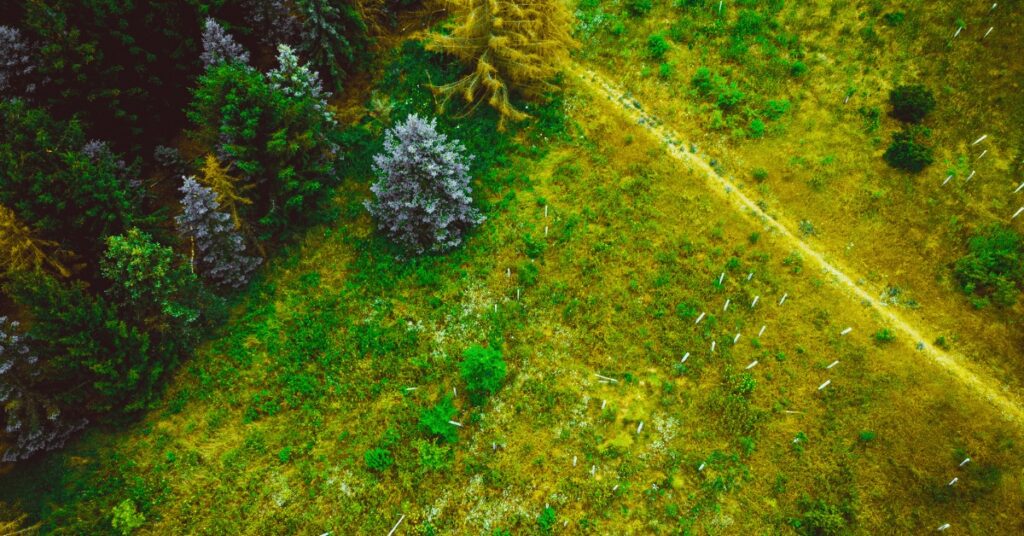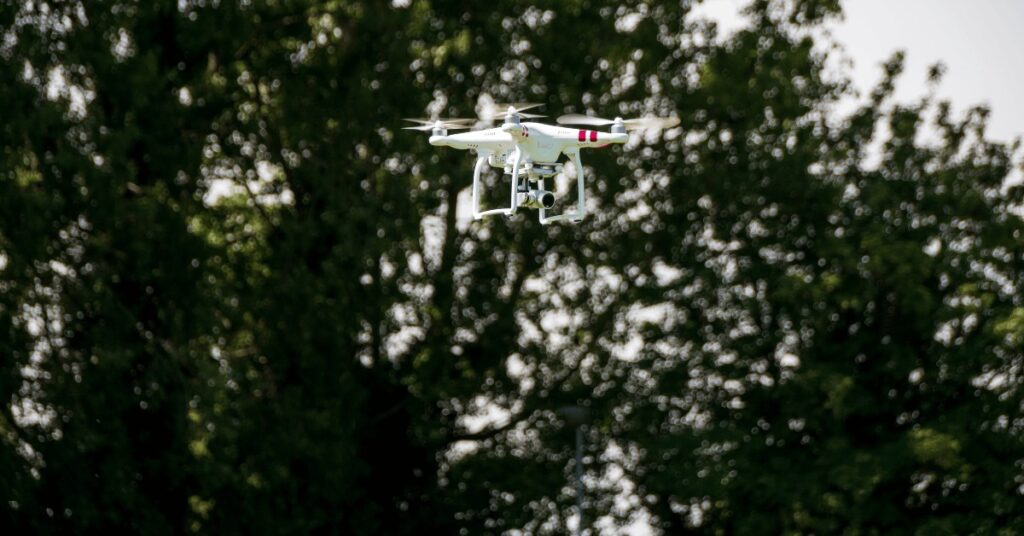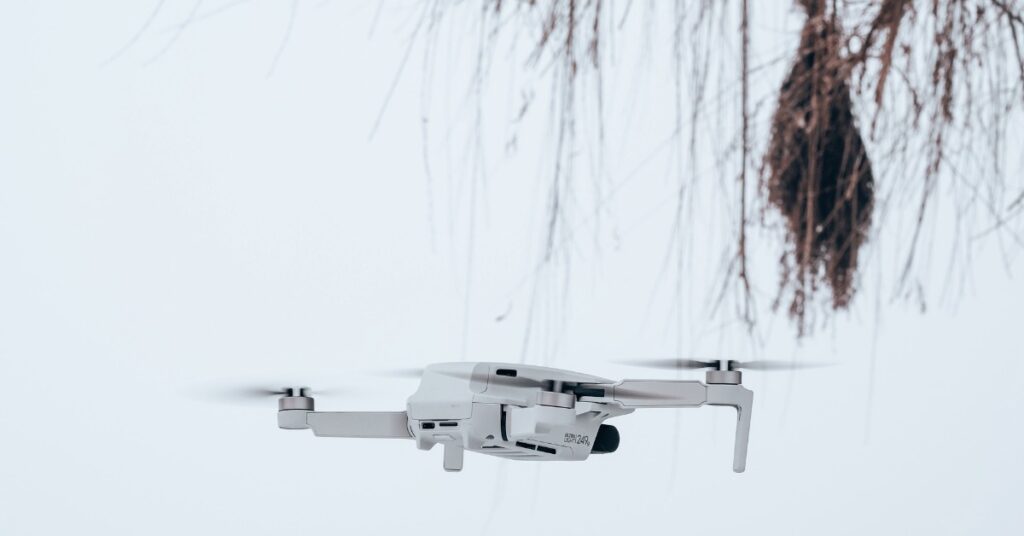Do Trees Block Drone Signals?

Have you ever wondered if trees can interfere with your drone’s signal? It’s a question that many drone pilots have asked, and for good reason.
After all, losing control of your drone due to signal interference can be a costly and potentially dangerous experience.
Do Trees Block Drone Signals?
Yes, trees can block drone signals. The water content in trees absorbs radio waves, which can cause signal interference.
This article will explore the relationship between trees and drone signal strength and provide tips and strategies for flying safely in tree-covered areas.
Can trees interfere with drone signals?
When it comes to flying drones, signal interference is a significant concern. Many drone pilots have reported losing control while flying in tree-covered areas. But can trees interfere with drone signals? Let’s take a closer look.
Simple answer: Yes, trees can interfere with drone signals.
How do trees affect drone signals?
Trees can interfere with drone signals by absorbing or reflecting the radio waves that transmit and receive data. This interference can result in a weaker signal and slower data transfer, which can cause issues such as loss of control or poor video quality.
What types of trees can block drone signals?
Trees with dense foliage, such as evergreens, can be more likely to interfere with drone signals than those with lighter foliage. Additionally, tall trees can block signals more effectively than shorter ones.

How can you fly a drone in forested areas without losing signal?
One way to avoid signal interference while flying in forested areas is to keep the drone in an open space as much as possible. You can also try flying at a higher altitude or using a signal booster to amplify the drone’s signal.
What other factors besides trees can affect drone signal strength?
Other factors affecting drone signal strength include weather conditions, electromagnetic interference, and radio frequency interference from nearby devices.
How do trees affect drone signal strength?
Trees and other obstacles can significantly affect the strength of a drone’s signal. Here’s how:
Foliage and Branches:
The leaves and branches of trees can weaken or block a drone’s signal. It is because the signal operates in the radio frequency range, which can be absorbed or reflected by certain types of materials.
Trees with denser foliage and thicker branches are more likely to interfere with the signal than those with lighter foliage and thinner branches.
Location:
The drone’s location in the trees can also affect signal strength. For example, if the drone is flying directly above a tree, the signal may weaken due to obstructing the tree’s branches and leaves.

Similarly, if the drone is flying through a dense forest, the many trees and other obstacles may disrupt the signal.
Distance:
The distance between the drone and the transmitter also affects signal strength. The farther away the drone is from the transmitter, the weaker the signal will be. It is because the signal weakens as it travels through the air and can be further weakened or blocked by obstacles like trees.
Overall, it’s essential to remember that trees and other obstacles can significantly impact a drone’s signal strength. To fly safely and avoid losing control of your drone, it’s essential to carefully consider the location, distance, and density of trees in the surrounding area.
What types of trees can block drone signals?
When it comes to drone flying, not all trees are created equal. While any tree can potentially block a drone’s signal to some degree, certain kinds of trees are more likely to cause interference than others. Here are some examples:
Evergreen trees:
These trees, which retain their needles year-round, can be particularly problematic for drone pilots. Their needles are dense than the leaves of deciduous trees, which can create a barrier that blocks or weakens the drone’s signal.

Leafy trees:
Deciduous trees, which lose their leaves in the fall, can also interfere with drone signals, significantly when their leaves are fully grown. It is because the leaves can absorb and scatter radio waves, which can cause signal loss or distortion.
Trees with metallic properties:
Some trees, like pine trees, contain natural metal deposits in their bark and needles. It can cause the tree to act like a conductor, amplifying or distorting the drone’s signal.
It’s worth noting that the specific type of tree isn’t the only factor that affects drone signal strength. The foliage’s thickness, the forest’s density, and even the time of day can all impact how well your drone communicates with the remote control.
READ MORE: How to use a parrot drone?
To minimize the risk of signal interference, it’s generally best to fly your drone in open areas with minimal tree cover. If you need to fly near trees, consider using a signal booster or antenna to amplify the signal or adjust your flight path to avoid areas with heavy tree cover.
Are tall trees more likely to block drone signals than shorter ones?
One of the biggest concerns when flying drones is maintaining a strong and consistent signal.
Trees, in particular, can pose a significant obstacle to maintaining a reliable connection between the remote control and the drone. But does the height of a tree directly impact the strength of a drone’s signal? Let’s take a closer look.

Height is just one factor that can impact drone signal strength. However, taller trees are generally more likely to cause signal interference than shorter ones.
It is because tall trees have more branches and leaves that can obstruct the signal, creating a physical barrier that weakens the connection between the drone and the remote control.
Factors that affect drone signal strength:
- Tree height
- Tree type
- Tree density
- Weather conditions
- Presence of other wireless signals
Tree type and density also play a role in signal interference. Trees with denser foliage and smaller leaves, such as evergreens, are more likely to cause signal interference than trees with sparser foliage and larger leaves.
Similarly, a forest with a higher density of trees will cause more signal interference than a forest with fewer trees.
It’s important to note that while tall trees may be more likely to cause signal interference, there are steps you can take to mitigate this issue. Some examples are using a signal booster or flying in a different location with fewer obstacles.
By understanding the factors that impact drone signal strength, you can better prepare for flying in different environments and maximize your chances of maintaining a strong and reliable connection.

Here are some tips for flying drones in forested areas:
- Fly at a lower altitude. The lower the drone is to the ground, the less likely it is to be affected by trees.
- Avoid flying near tall trees. If you must fly near tall trees, try to fly on the opposite side of the tree from the controller.
- Use a signal booster. A signal booster can help to improve drone signal strength in areas with a lot of interference.
- Be aware of your surroundings. If you lose signal, land the drone immediately.
How can you fly a drone in forested areas without losing signal?
If you’re planning to fly your drone in a forested area, there are a few steps you can take to minimize the risk of losing signal and ensure a safe and enjoyable flight. Here are some tips:
Choose the Right Time of Day:
The best time to fly a drone in a forested area is during the early morning or late afternoon when the sun is lower in the sky. It will minimize the impact of shadows and help you maintain a clear line of sight with your drone.
Use a Signal Booster:
A signal booster is one of the most effective ways to increase drone signal strength. This device attaches to your drone’s remote controller and amplifies the signal, allowing you to fly further and higher without losing connection.
Clear the Flight Path:
Before takeoff, clear any obstacles or branches that may interfere with your drone’s signal. It will help maintain a clear line of sight between your drone and the remote controller.

Adjust Your Antenna:
Depending on your drone model, you can adjust the antenna to improve signal strength. Be sure to consult your drone’s manual for instructions on how to do this.
Be Mindful of Your Surroundings:
Finally, always be aware of your surroundings when flying a drone in a forested area. Look for potential signal blockers like tall trees or dense foliage, and avoid flying in areas with heavy electromagnetic interference.
Can you use a signal booster to improve drone signal in tree-covered areas?
There are a few things to keep in mind when using a signal booster:
- Make sure the signal booster is compatible with your drone and controller.
- Place the signal booster in a location where it will have a clear line of sight to both the drone and the controller.
- Keep the signal booster away from metal objects, as these can interfere with the signal.
- Test the signal booster before you fly your drone to make sure it is working properly.
READ MORE: Does Mavic 3 have optical zoom?
If you are having trouble flying your drone in a tree-covered area, a signal booster can be helpful. However, it is essential to remember that a signal booster cannot overcome all interference. If you fly in an area with much interference, you may still experience signal loss.

What is a signal booster?
A signal booster, also known as an amplifier or a repeater, is a device that can improve the strength of a wireless signal.
In the case of drones, a signal booster can increase the range and stability of your drone’s signal, even in areas with tree cover or other obstructions.
How does a signal booster work?
A signal booster works by amplifying the signal that your drone is sending and receiving. Essentially, the booster takes the weak signal from your drone’s transmitter and amplifies it before sending it out again.
It can improve the range and quality of the signal, making it easier to control your drone and receive video feedback.
It’s important to note that not all signal boosters are created equal. Some may work better than others, depending on the specific drone and the environment in which you’re flying.
Additionally, signal boosters can be expensive, so it’s important to consider whether it’s worth the investment for your particular use case.
What other factors besides trees can affect drone signal strength?
Aside from trees, several other factors can affect drone signal strength. This section will explore some of the most common elements and explain how they can impact your drone’s signal.

Obstacles:
Obstacles such as buildings, mountains, and power lines can interfere with your drone’s signal. The more barriers between your drone and the controller, the weaker the signal will likely be.
Interference from other electronics:
Electronic devices such as cell phones, radios, and Wi-Fi routers can also interfere with your drone’s signal. It’s important to avoid flying your drone in areas with many electronic devices in use.
Weather conditions:
Weather conditions can also impact your drone’s signal. Rain, fog, and other forms of precipitation can weaken the signal, as can strong winds.
Distance:
The farther your drone is from the controller, the weaker the signal will likely be. It’s essential to keep your drone within range of the controller to avoid losing the signal.
Battery life:
Low battery life can also impact your drone’s signal strength. As the battery drains, the signal may weaken, making it more difficult to control your drone.

What should you do if you lose a drone signal while flying in a forest?
Losing your drone signal in a forest can be a nerve-wracking experience, but it’s essential to stay calm and take action quickly. Here are some steps you can take if you lose your drone signal while flying in a forest:
Stay calm, and don’t panic.
It’s easy to panic when you lose your drone’s signal, but this won’t help you regain control. Take a deep breath, stay calm, and focus on the steps you must take to regain control.
Try to reconnect the signal.
If you lose your drone signal, the first thing you should try to do is reconnect it. Check your controller and drone to ensure they are turned on and connected correctly. Try moving to a different location to see if you can re-establish the connection.
Move your drone to a clear area.
Trees or other obstructions may block your drone’s signal if you’re flying in a forest. Try moving your drone to a clear area with a better line of sight than your controller.
Fly your drone back manually.
If you cannot reconnect your drone signal, you may need to fly it back manually. Use your controller to guide the drone back to your location, closely monitoring its altitude and surroundings.
Retrieve your drone
Once your drone is back in control, retrieve it safely and carefully. Check for damage to the drone or its components before flying it again.
If you cannot land the drone manually, the next thing you should do is contact the drone manufacturer. They may be able to help you regain signal or land the drone.

Here are some additional tips for what to do if you lose a drone signal while flying in a forest:
- Be aware of your surroundings. If you lose the signal, you may not be able to see the drone. Be careful not to walk into it or trip over it.
- Do not panic. Losing a signal is not the end of the world. By following these tips, you can help to ensure that you and your drone are safe.
How does the thickness of tree leaves and branches impact the drone signal?
Regarding drone signal interference, the thickness of tree leaves and branches can play a significant role.
Impact of Leaf Density on Drone Signal Strength
The density of leaves on a tree can directly impact the strength of your drone’s signal. When your drone’s signal travels through a dense layer of leaves, it can weaken or disrupt, resulting in poorer signal strength.
As a result, you may experience video lag or loss of control over your drone.
Effect of Branches on Drone Signal Strength
The thickness of tree branches can also play a role in drone signal interference. Thicker branches are more likely to obstruct your drone’s signal and cause a reduction in signal strength.
It is because the signal may need to travel through more obstacles and undergo more interference, resulting in a weaker signal.
What are some strategies for avoiding drone signal interference when flying near trees?
When flying your drone near trees, you may encounter interference with your signal. It can be frustrating and even dangerous if you lose drone control. Fortunately, there are several strategies you can use to avoid signal interference and fly safely in tree-covered areas.

Fly higher:
One effective strategy is to fly your drone higher than the tree canopy. It will help you avoid any interference caused by the trees’ leaves and branches.
However, it’s essential to keep in mind that flying too high can also cause issues with signal interference from other sources, so finding the right balance is critical.
Use line-of-sight:
Another strategy is always to keep your drone within your line of sight. It means you should avoid flying your drone behind trees or other obstacles that can block your view. Keeping your drone within your line of sight will give you a better chance of maintaining a strong signal.
Adjust your antennas:
Most drones have adjustable antennas that can be tilted to improve signal strength—experiment with adjusting your antennas to find the best angle for flying in tree-covered areas. You can also use a signal booster or an external antenna to improve your signal strength.
Choose the right location:
When flying in a forested area, try to find a location with fewer trees or open spaces to minimize signal interference. Avoid flying near power lines, buildings, and other sources of electromagnetic interference.
Use a GPS drone:
Lastly, consider using a GPS drone, which can help maintain a steady signal even in areas with heavy tree cover. These drones use GPS technology to maintain stability and can be easily controlled in challenging environments.

Implementing these strategies can improve your drone’s signal strength and avoid interference when flying near trees. Remember always to prioritize safety and follow local regulations when flying your drone.
Important FAQs
How can I block drone signals?
Is it possible to stop drones from flying over my house?
Is there a drone jammer app I can use?
Final Thoughts
In conclusion, flying a drone near trees can challenge maintaining a strong signal.
However, by implementing strategies such as flying higher, using line-of-sight, adjusting antennas, choosing the right location, and using a GPS drone, you can avoid interference and fly safely in tree-covered areas.
Remember always to prioritize safety and follow local regulations when flying your drone.
If you found this article helpful, please share it with other drone enthusiasts and leave a comment below, sharing your tips and experiences. And if you have any further questions or suggestions for future articles, don’t hesitate to reach out.
How to Get a Drone License in Florida? | A Comprehensive Guide.
“Ready to take flight in the Sunshine State? 🌞 Discover everything you need to know about getting your drone license in Florida. Your ticket to drone adventures awaits – read now!”







